Drug Screening Market Size
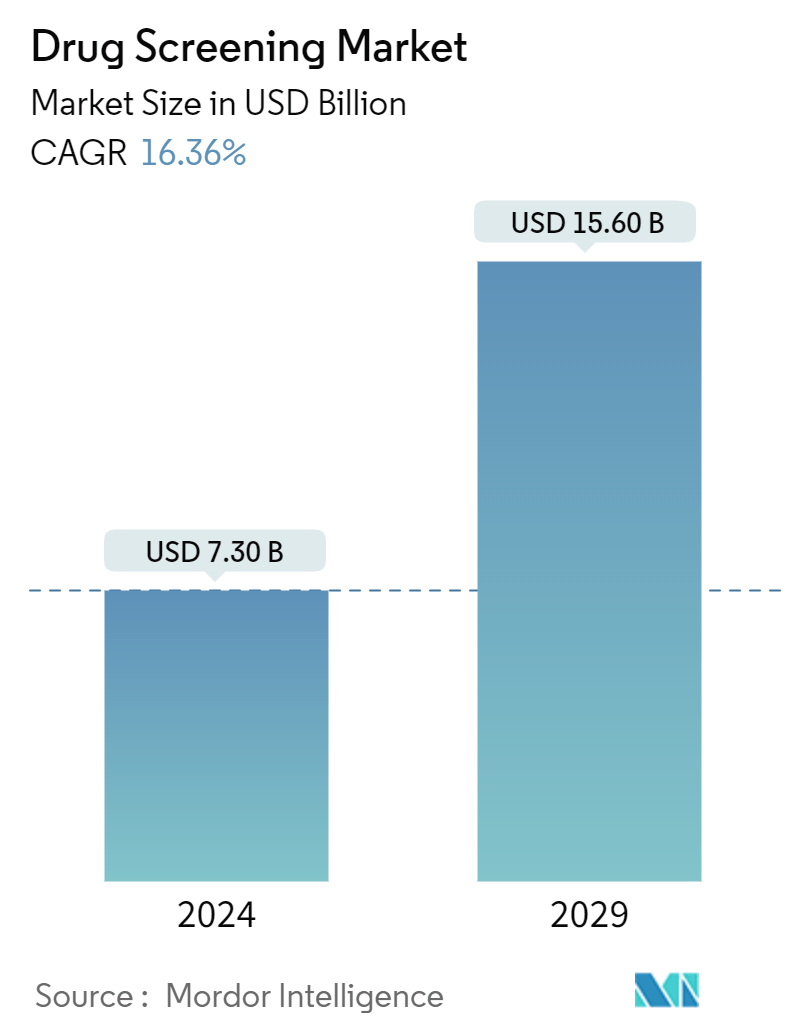
| Study Period | 2021 - 2029 |
| Market Size (2024) | USD 7.30 Billion |
| Market Size (2029) | USD 15.60 Billion |
| CAGR (2024 - 2029) | 16.36 % |
| Fastest Growing Market | Asia-Pacific |
| Largest Market | North America |
Major Players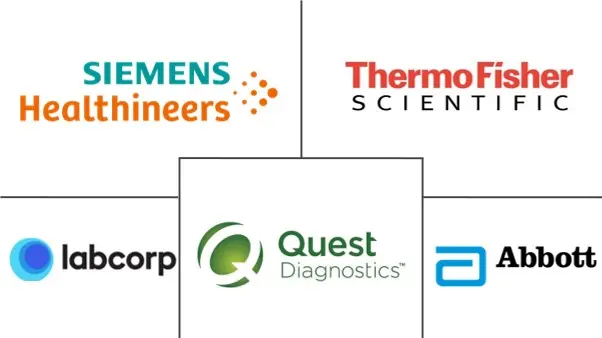
*Disclaimer: Major Players sorted in no particular order |
Drug Screening Market Analysis
The Drug Screening Market size is estimated at USD 7.30 billion in 2024, and is expected to reach USD 15.60 billion by 2029, growing at a CAGR of 16.36% during the forecast period (2024-2029).
The global drug screening market is primarily fueled by factors such as the rise in drug and alcohol consumption, stringent alcohol and drug testing regulations, generous government funding for pharmaceutical research, and expedited regulatory approvals.
The increasing consumption of drugs is expected to increase demand for drug screening products, which is anticipated to boost the market growth. For instance, approximately 83.4 million adults (29%) in the European Union reportedly used illicit drugs at least once, according to the 2023 European Drug Report. Cannabis is the predominant illicit drug consumed in Europe, with an estimated 8% of European adults using it in 2022, based on national surveys. A large share of the population consumes drugs, impacting the lives of individuals and is likely to increase demand for drug screening, thereby boosting segment growth.
The increasing consumption of drugs and alcohol is expected to increase the demand for drug screening in hospital settings, which is likely to boost market growth over the forecast period. As per the national statistics published by the UK government in December 2023, between April 2022 and March 2023, 290,635 adults received support for substance use issues. This was a small rise compared to the 289,215 recorded the previous year. The same source stated that the number of adults getting treatment was 137,749 from 2022 to 2023, higher than the previous two years’ figures of 130,490 and 133,704. The rise in drug and alcohol consumption is often linked to public safety concerns, which is likely to boost market growth.
Several laws and regulations mandate drug and alcohol testing in various sectors, and the implementation of such laws is expected to increase the demand for drug screening products and devices, which is likely to contribute to market growth over the forecast period. For instance, in November 2022, the Federal Motor Carrier Safety Administration (FMCSA) released updates outlining the drug and alcohol testing requirements that were implemented by the FMCSA and its preceding agency. These regulations specify the individuals subject to testing, the frequency of testing, and the circumstances triggering testing. Additionally, the regulations safeguard employee privacy by limiting the use and disclosure of sensitive drug and alcohol testing information by employers and service agents.
The presence of key market players and their continuous efforts to expand drug screening products are expected to fuel market growth. For instance, in December 2023, test kits for date rape drugs were available in emergency rooms across all Quebec hospitals. These test kits can detect over 200 psychoactive substances, including gamma-hydroxybutyrate (GHB), called a date-rape drug.
Thus, growing alcohol and drug consumption and stringent regulations for drug screening, along with product launches, are expected to contribute to market growth over the forecast period. Alcohol and drug consumption prohibitions in certain countries impede the global drug screening market's expansion. Restrictions on drug testing in workplaces, especially in developed economies, further hinder market growth.
Drug Screening Market Trends
The Instruments Segment is Expected to Show Significant Growth Over the Forecast Period
The instruments used for drug screening include immune assays, gas chromatography, mass spectrometry, and various other instruments and color tests. Immunoassays are widely used due to their accuracy and rapid test results. Chromatography and spectrometry instruments also offer accurate results for drug screening. Color tests involve reagents like Marquis reagent, Dille-Koppanyi reagent, Van Urk reagent, and Scott test, each reacting with specific substances to produce different colors. The benefits of drug screening instruments vary according to the detection window, ease of sampling, and potential for adulteration.
Factors such as the benefits offered by the instruments for treating drug screening and the increase in research activities to demonstrate the advantages of different immunoassays in screening drugs are expected to drive the segment's growth over the forecast period.
Immunoassays are commonly utilized in clinical settings for the swift detection of drugs in urine. Common formats of immunoassays used for drugs of abuse testing include EMIT (enzyme multiplied immunoassay technique), CEDIA (cloned enzyme donor immunoassay), chemiluminescent immunoassays (CLIA), KIMS (kinetic interaction of microparticle in solution), etc. Various key players across the globe have introduced and enhanced their advanced drug testing panels and immunoassays for drug screening purposes, which is expected to impact segment growth over the forecast period.
- In December 2023, Quest Diagnostics, one of the significant providers of diagnostic information services, launched a new confirmatory testing service for novel psychoactive substances (NPS). The new panel, which tests for 88 compounds, covers a broad array of drug classes, such as designer opioids, designer benzodiazepines, designer stimulants, fentanyl analogs, synthetic cannabinoids, and other illicit additives.
- In October 2023, ProciseDx Inc. received de novo FDA clearance for the therapeutic drug monitoring (TDM) tests for adalimumab (Humira and biosimilar Amgevita) and infliximab (Remicade and biosimilars Inflectra and Renflexis). These assays, called Procise ADL and Procise IFX, are used to quantify adalimumab (ADL) and infliximab (IFX) in patients suffering from inflammatory bowel diseases (IBD) who take these drugs. ProciseDx was expected to commercialize these first FDA-cleared infliximab and adalimumab drug monitoring tests in Q4 2023.
Therefore, owing to the above-mentioned factors, such as the benefits of various instruments in drug screening and other strategic product launches, the segment is expected to witness notable growth over the forecast period.
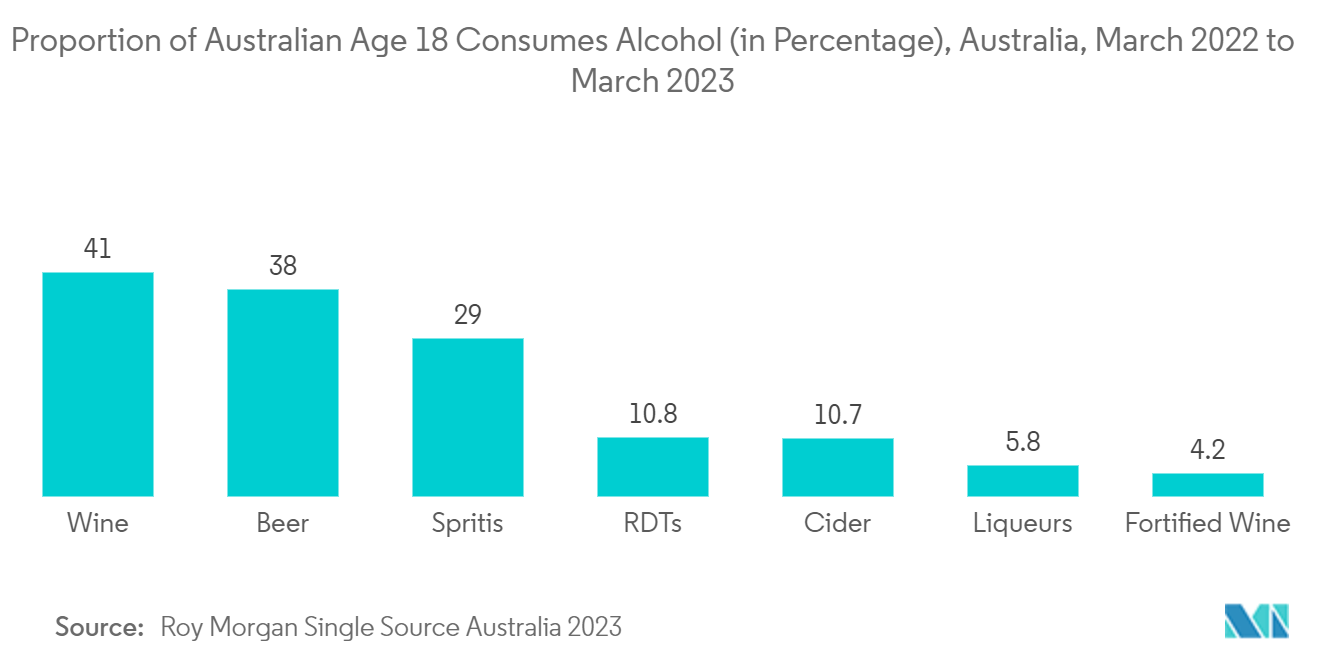
North America is Expected to Hold a Significant Market Share Over the Forecast Period
North America is anticipated to maintain a substantial market share in the drug screening market owing to the concerning issue of excessive alcohol consumption. The prevalent use of illicit drugs, coupled with government funding allocated for combating drug abuse, further contributes to the demand for drug screening. Stringent regulations within the region provide an additional impetus for drug screening practices.
The growing substance abuse rates fuel the need for drug screening in healthcare facilities and workplace facilities, which is anticipated to contribute to market growth. For instance, in February 2023, according to an article published by Pennsylvania State University, around 63% of adults aged 18 years and above consumed alcohol in the United States in 2022. Among these, males (66%) accounted for higher alcohol consumption compared to females (61%). Thus, the large number of alcohol consumers raises the need for drug-testing products and services, driving market growth.
Stringent government regulations that require drug testing in different sectors like transportation raise the usage of drug screening products and are anticipated to fuel market growth. For instance, in May 2023, the US Department of Transportation regulated the drug testing program by including oral fluid testing to improve safety and reduce the chances of cheating involved with urine drug tests. Thus, such stringent regulations for identifying drug users are expected to increase the usage of drug screening products in the United States, thereby propelling market growth.
The increasing research activities for the technological advancements in drug testing products are expected to fuel market growth. For instance, in June 2023, the National Institutes of Health (NIH) and the FDA) emphasized more research for the improvement and implementation of drug-checking tools, such as fentanyl test strips, which are beneficial for reducing drug-related harms and saving lives of substance abuse users with overdose. Such research activities for the development of advanced drug screening products will likely be adopted to determine drug users, which is anticipated to drive market growth in the region over the forecast period.
The presence of market players and their continuous efforts to develop advanced drug screening products are expected to bolster the country’s market growth. For instance:
- In December 2023, Quest Diagnostics introduced the new confirmatory testing service panel test for novel antipsychotic substances. This 88-compound panel test includes different drug classes, such as opioids, benzodiazepines, stimulants, fentanyl analogs, synthetic cannabinoids, and other illicit additives. This panel test assists healthcare workers in identifying drug misuse among patients prescribed controlled medications, such as opioids and other substances.
- In February 2023, according to the norms of law, individuals in Minnesota are required to undergo saliva drug testing to determine the presence of drugs, alcohol, cannabis, and other metabolites while applying for jobs.
Therefore, owing to the growing prevalence of alcohol and other drug consumption and increasing government regulations, coupled with the new products and services launched, the market is expected to record growth during the forecast period.
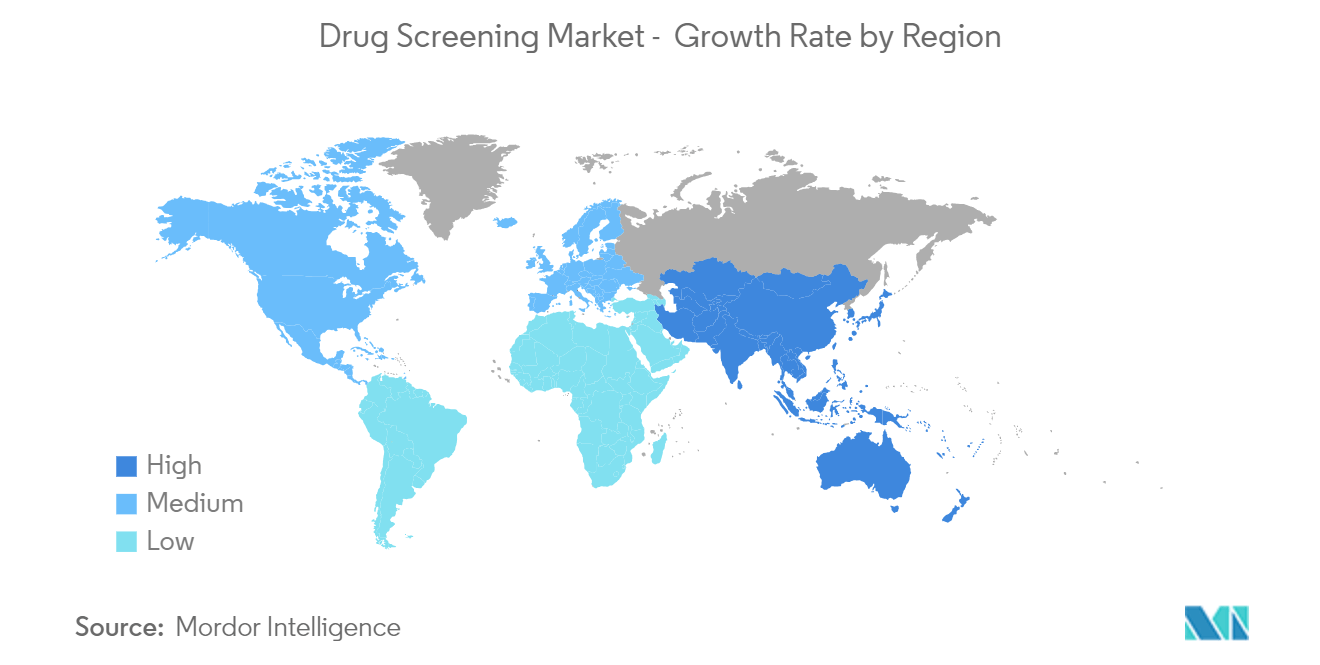
Drug Screening Industry Overview
The drug screening market is semi-consolidated in nature due to the presence of several companies operating globally and regionally. The companies are involved in various strategic activities such as product launches, collaborations, and acquisitions. Key players operating in the global drug screening market are LabCorp (Laboratory Corporation of America Holdings), Quest Diagnostics, Abbott Laboratories, Thermo Fisher Scientific Inc., Alfa Scientific Designs Inc., OraSure Technologies Inc., Siemens Healthineers, F. Hoffmann-La Roche Ltd, Shimadzu Corporation, LifeLock Technologies, Drägerwerk AG & Co. KGaA, and Premier Biotech Inc.
Drug Screening Market Leaders
-
Quest Diagnostics
-
Abbott Laboratories
-
Thermo Fisher Scientific, Inc.
-
Siemens Healthineers
-
LabCorp (Laboratory Corporation of America Holdings)
*Disclaimer: Major Players sorted in no particular order
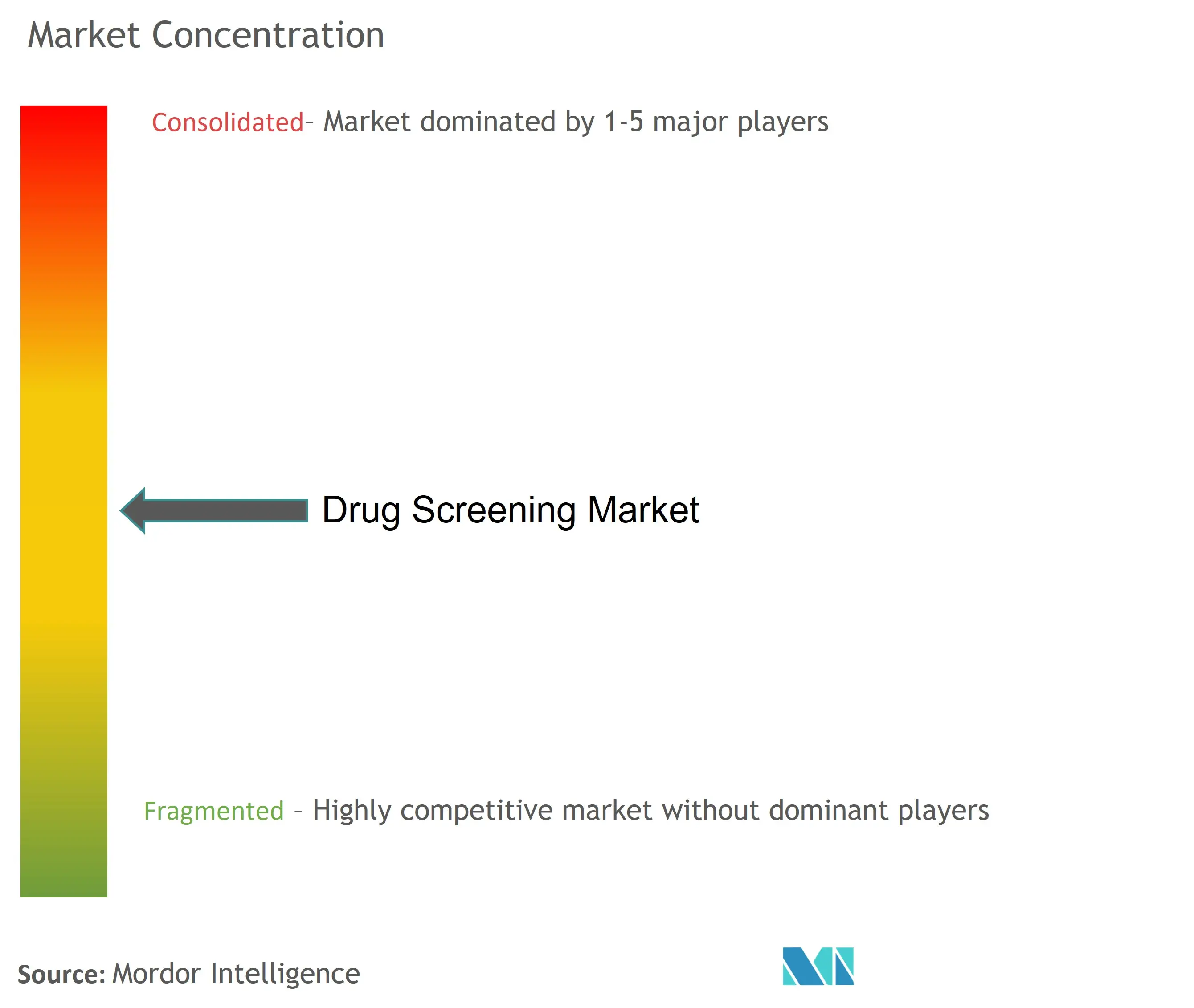
Drug Screening Market News
- February 2024: Mobile Health introduced a new rapid drug testing service in New York clinics for employers to screen and hire candidates easily.
- March 2023: Shenzhen Superbio Technology Co. Ltd (Superbio) received clearance from the US Food and Drug Administration (FDA) on the first-ever point-of-care instrument intended for the qualitative detection of fentanyl in human urine and fully released authorization to Bioeasy USA Inc. (Bioeasy) for this product in the United States.
Drug Screening Market Report - Table of Contents
1. INTRODUCTION
- 1.1 Study Assumptions and Market Definition
- 1.2 Scope of the Study
2. RESEARCH METHODOLOGY
3. EXECUTIVE SUMMARY
4. MARKET DYNAMICS
- 4.1 Market Overview
-
4.2 Market Drivers
- 4.2.1 Growing Drug & Alcohol Consumption
- 4.2.2 Enforcement of Stringent Laws Mandating Drug & Alcohol Testing
-
4.3 Market Restraints
- 4.3.1 Ban on Alcohol Consumption in Several Islamic Countries
-
4.4 Porter's Five Force Analysis
- 4.4.1 Threat of New Entrants
- 4.4.2 Bargaining Power of Buyers/Consumers
- 4.4.3 Bargaining Power of Suppliers
- 4.4.4 Threat of Substitute Products
- 4.4.5 Intensity of Competitive Rivalry
5. MARKET SEGMENTATION (Market Size by Value - USD)
-
5.1 By Product and Service
- 5.1.1 Consumables
- 5.1.2 Instruments
- 5.1.3 Rapid Testing Devices
- 5.1.4 Services
-
5.2 By Sample Type
- 5.2.1 Urine Samples
- 5.2.2 Oral Fluid Samples
- 5.2.3 Hair Samples
- 5.2.4 Other Samples
-
5.3 By End User
- 5.3.1 Drug Testing Laboratories
- 5.3.2 Hospitals
- 5.3.3 Others
-
5.4 Geography
- 5.4.1 North America
- 5.4.1.1 United States
- 5.4.1.2 Canada
- 5.4.1.3 Mexico
- 5.4.2 Europe
- 5.4.2.1 Germany
- 5.4.2.2 United Kingdom
- 5.4.2.3 France
- 5.4.2.4 Italy
- 5.4.2.5 Spain
- 5.4.2.6 Rest of Europe
- 5.4.3 Asia-Pacific
- 5.4.3.1 China
- 5.4.3.2 Japan
- 5.4.3.3 India
- 5.4.3.4 Australia
- 5.4.3.5 South Korea
- 5.4.3.6 Rest of Asia-Pacific
- 5.4.4 Middle East and Africa
- 5.4.4.1 GCC
- 5.4.4.2 South Africa
- 5.4.4.3 Rest of Middle East and Africa
- 5.4.5 South America
- 5.4.5.1 Brazil
- 5.4.5.2 Argentina
- 5.4.5.3 Rest of South America
6. COMPETITIVE LANDSCAPE
-
6.1 Company Profiles
- 6.1.1 LabCorp (Laboratory Corporation of America Holdings)
- 6.1.2 Quest Diagnostics
- 6.1.3 Abbott Laboratories
- 6.1.4 Thermo Fisher Scientific Inc.
- 6.1.5 Alfa Scientific Designs Inc.
- 6.1.6 OraSure Technologies Inc.
- 6.1.7 Siemens Healthineers
- 6.1.8 F. Hoffmann-La Roche Ltd
- 6.1.9 Shimadzu Corporation
- 6.1.10 LifeLoc Technologies
- 6.1.11 Drägerwerk AG & Co. KGaA
- 6.1.12 Premier Biotech Inc.
- *List Not Exhaustive
7. MARKET OPPORTUNITIES AND FUTURE TRENDS
** Subject To AvailablityDrug Screening Industry Segmentation
Drug screening is a method for detecting the presence of certain illegal or prescription medications in a person's blood, urine, or other biological samples.
The drug screening market is segmented by product and service, sample type, end user, and geography. By product and service, the market is segmented as consumables, instruments, rapid testing devices, and services. By sample type, the market is segmented into urine samples, oral fluid samples, hair samples, and other samples. By end user, the market is segmented into drug testing laboratories, hospitals, and others. By geography, the market is segmented into North America, Europe, Asia-Pacific, the Middle East and Africa, and South America. The report also covers the estimated market sizes and trends for 17 different countries across major regions globally. The report offers the value (USD) for all the above segments.
| By Product and Service | Consumables | |
| Instruments | ||
| Rapid Testing Devices | ||
| Services | ||
| By Sample Type | Urine Samples | |
| Oral Fluid Samples | ||
| Hair Samples | ||
| Other Samples | ||
| By End User | Drug Testing Laboratories | |
| Hospitals | ||
| Others | ||
| Geography | North America | United States |
| Canada | ||
| Mexico | ||
| Geography | Europe | Germany |
| United Kingdom | ||
| France | ||
| Italy | ||
| Spain | ||
| Rest of Europe | ||
| Geography | Asia-Pacific | China |
| Japan | ||
| India | ||
| Australia | ||
| South Korea | ||
| Rest of Asia-Pacific | ||
| Geography | Middle East and Africa | GCC |
| South Africa | ||
| Rest of Middle East and Africa | ||
| Geography | South America | Brazil |
| Argentina | ||
| Rest of South America |
Drug Screening Market Research FAQs
How big is the Drug Screening Market?
The Drug Screening Market size is expected to reach USD 7.30 billion in 2024 and grow at a CAGR of 16.36% to reach USD 15.60 billion by 2029.
What is the current Drug Screening Market size?
In 2024, the Drug Screening Market size is expected to reach USD 7.30 billion.
Who are the key players in Drug Screening Market?
Quest Diagnostics, Abbott Laboratories, Thermo Fisher Scientific, Inc., Siemens Healthineers and LabCorp (Laboratory Corporation of America Holdings) are the major companies operating in the Drug Screening Market.
Which is the fastest growing region in Drug Screening Market?
Asia-Pacific is estimated to grow at the highest CAGR over the forecast period (2024-2029).
Which region has the biggest share in Drug Screening Market?
In 2024, the North America accounts for the largest market share in Drug Screening Market.
What years does this Drug Screening Market cover, and what was the market size in 2023?
In 2023, the Drug Screening Market size was estimated at USD 6.11 billion. The report covers the Drug Screening Market historical market size for years: 2021, 2022 and 2023. The report also forecasts the Drug Screening Market size for years: 2024, 2025, 2026, 2027, 2028 and 2029.
Drug Screening Industry Report
Statistics for the 2023 Drug Screening market share, size and revenue growth rate, created by Mordor Intelligence™ Industry Reports. Drug Screening analysis includes a market forecast outlook to 2029 and historical overview. Get a sample of this industry analysis as a free report PDF download.



